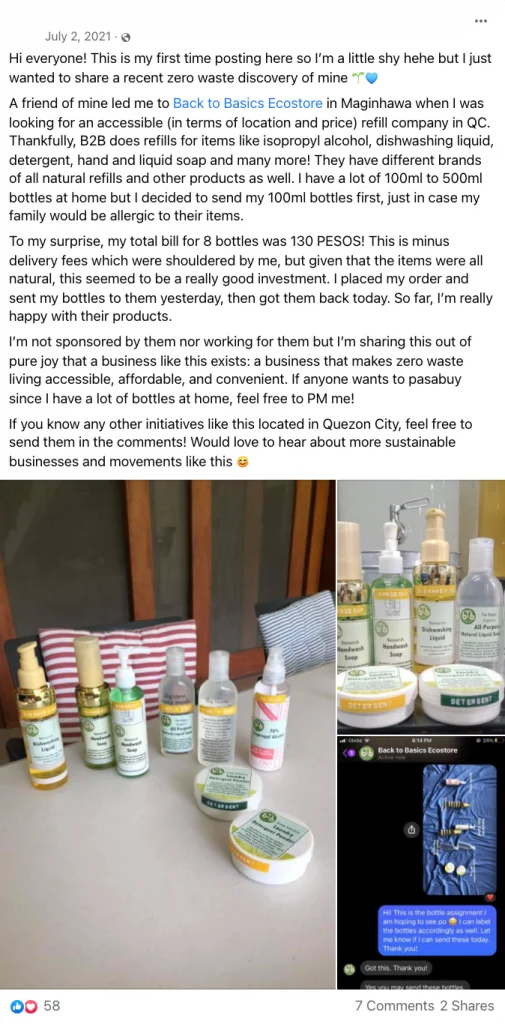Reasons You Should Invest in a Community Management
Author & Editor
Content Team Lead
Published on: Jan 20, 2022 Updated on: Mar 19, 2025

Table of Contents
A community management digital strategy is your best bet in engaging online customers. This is because getting people to rally behind your brand is worth more than quick sales.
As a veteran digital marketing company, we've seen many testaments to the truth of this. And we dive into the details for those of you who are not quite sold on the idea.
What is community management and what is it for?
First, let's talk about what community management is.
Community management is a term often interchanged with social media management. And this is perhaps because the role of the content manager is both fluid and diverse. Another reason is that community management is widely practiced within social media platforms.
So yes. In a way, community management is a facet of social media management. But while the latter does build an audience, it isn't concern itself that much with community mobilization.
Community management, meanwhile, does involve posting content (much like social media management). But it does so with the whole intent to spark conversations between your brand and community. These interactions are all aimed at building one thing: Trust in and loyalty to your brand.
To achieve this, your community managers shuffle between being a customer service representative, expert, and friend to your online customers.
How is a community management digital strategy executed?
There are many ways you can practice community management. Some involves replying to audiences' comments, or asking questions to spark exchange.
Others do it by creating specific Facebook groups. In these bubbles, audiences gather and discuss things related to your common interests.
READ ALSO: 9 Facebook Community Management Tips from Group Admins
Starting to sound emotionally laborious? Well, it is. And, among other things, this is the reason why brands neglect, or even dismiss the strategy.
But the way our online environment has evolved has underscored its importance. Making it unignorable.
How has community management changed over the years?
Community management is arguably the most social social media marketing can get. And it evolves a lot like our offline social settings do. It's a transition you're both aware of, and not quite aware of.
But to pin it down, here are a few concrete ways community management has changed:
| Then | Now | |
| As a social media marketing tactic | Optional | Must-have |
| Brand-customer communications | One-sided; usually only the brand provides information | Operates around the customer feedback loop; customers as a source of or content collaborator |
| Responding to audience needs and concerns | Reactive, more on cisis management | Proactive, and improves brand experience before complaints get out of hand |
| Attention given to community members | Touch and go | Consistently maintained |
But why should you care about these shifts? What benefit does that bring your business?
Why a community management digital strategy is important
It's important to note that community management digital strategy is a long-game approach.
This means you may not see the benefits below in a month, or even three months' time – at least. But while it won't gaurantee quick wins, you can look forward to it gaining you durable ones.
Meaning, you can expect the returns to sustain and stabilize for your business:
1. Solidifies brand trust and boosts customer retention.
In marketing, brand trust is one of the most sought-after and guarded results of marketers. This is because the more customers trust you, the more willing they are to transact.
Many studies into the impact of brand trust and customer retention show the evidence to this claim. As one study notes, brand trust is one of the most important factors affecting repurchase intention. And online brand communities play a key role in helping nurture this trust.
And while there are many ways you can build and maintain brand trust, none but a community management digital strategy excels at achieving its integral aspect: Relationships.
With community management at its heart, online brand communities are both the medium and environment where customers interact with your brand. But in terms what your customers expect you to do in these communities, it's surely not to become an intermediary.
Rather, your brand should operate and interact as part of the community – giving valuable advice, and becoming a trusted confidant to your members.
2. Improves user experience of your brand.
In our online world today, brand experience equates to brand value. Negative experiences with your brand will hurt your brand equity, while positive ones will build it up.
But what does community management have to do with building experiences? Isn't that more to do with customer experience strategy? Well, yes. But only in part.
Because you see, for a customer experience strategy to exist, you'll first need data. Specifically, data on how your customers perceive and experience (both positive and negative) your brand.
READ ALSO: Customer Experience Strategy Best Practices to Drive Digital Wins
And be it qualitative of quantitative, the best data source is always your community and, hence, your community management digital strategy. Through your community management digital strategy, you can mine for direct feedback on your brand through various techniques.
Techniques like social listening, surveys, polls, and focus group discussions are all easily at the disposal of your community managers. Once mined, you can then strategize a response.
It can be through a app update, or a major one like a full rebranding. But the only way to know for sure if it'll impact and better the experience of your audience is through asking them.
Discovering the need for virtual experiences through community
A perfect example of this is what Jeff Lo, founder and editor-in-chief of Pinoy Fitness. Operating both as a publication and race organizer, it's helped thousands of Filipinos begin and sustain their fitness journeys.
Their story of community management digital strategy began in 2017. A time when online communities were just beginning to spring up. At this time, they were one of the few organizations to establish a community, and there came the birth of the Pinoy Fitness Community.
On top of key insights on what topics to cover for the publication, Jeff would also discover a key insight to racing from this community. An insight that would then lead to an innovation which now serves as a critical solution to their community in the pandemic. As Jeff puts it:
The community promotes conversations, between the brand and members about what they are passionate about. In return, it helped us know what the community needs and helps us develop products and solutions that can help and solve their problems"
He says this in reference to the Pinoy Fitness Atleta App - its virtual racing platform which was launched a year after the community page on Facebook was established. Through this app, runners who love racing were still provided an opportunity to run and win medals. A service undoubtedly cut-off by the pandemic and its restrictions.
3. It generates organic discussions about your brand.
Word of mouth remains to be one of the most potent brand promotion avenues. Because, going back to our point on brand trust, this manner of promotion is the most trusted by customers.
That's what all the brand reviews - on Google, social media, and your website - exist. It's all there to provide your customers with social proof that they can trust your brand. But the struggle you may often encounter with this is in compelling audiences to talk about you.
One thing that a community management digital strategy is again, excellent at. Because recommendations, brand mentions, and user-generated content naturally spring forth from community conversations.
Harness the community for promoting your brand
Let's take a look at a few examples from the Buhay Zero-Waste Facebook community - a community built to help educate people about living a sustainable or, in this case, zero-waste lifestyle.
[caption id="attachment_18357" align="aligncenter" width="505"] WORD OF MOUTH IN COMMUNITIES. This is an organic post from a community member in the group Buhay Zero-Waste. This content isn't prompted by anything other than the intent to share their learnings with other members. Screenshot from the Buhay Zero-Waste Facebook Group.[/caption]
WORD OF MOUTH IN COMMUNITIES. This is an organic post from a community member in the group Buhay Zero-Waste. This content isn't prompted by anything other than the intent to share their learnings with other members. Screenshot from the Buhay Zero-Waste Facebook Group.[/caption]
All over the community's Facebook group, you can see posts like these. Posts where products, stores, and services are organically promoted by their members.
This is because one of the main hurdle in practicing zero-waste living is awareness. Awareness of alternative solutions - where and how to get a hold of them.
It's also because of posts like these that you would want to and should participate in the conversation. Be it through starting your own community, or through partnering with community administrators to spark a discussion, will go a long way in generating organic conversations around and about your brand.
4. It humanizes your brand and improves brand-customer relationships.
All brands have stories. And when it comes to marketing, how you tell your brand story can make or break your value to your online customers. To be exact, it all relies on how well you can humanize your brand.
In a survey conducted by Sprout Social, one of the key insights they found about brand-customer relationships is that people (your audiences) are becoming more interested in learning about the people behind a brand.
To be exact, 65% of consumers expressed that they feel more connected to a brands if it has a strong presence on social media. Dissecting this further, audiences find more valuable connections with brands whose chief executives and employees share information about the brand online.
So, in a way, your employees' social media pages and how they talk about your brand online is, in itself, an act of community management. And one that fosters real connections that audiences feel are more genuine than if it were a brand name interacting with them.
Miss Nina putting her foot down, and making a statement
Let's look to Colourette Cosmetics and Every Body PH founder and CEO, Nina Ellaine Dizon-Cabrera as an example of humanizing the brand.
To demonstrate unshakable brand values and principles, Nina engages with community feedback - good, bad, and even trollish - in a way that's on-brand for her Colourette, and Every Body. Confident, and unapologetic in their own skin.
Though it doesn't always translate in revenue, Nina's efforts to engage and educate her community has made her and her brands' social media one that they can relate to. One that audiences connect a familiar face to. And, more importantly, one that they can rely on.
Happy Saturday! Let me share a few pointers: 🤍
1. What you wear should never be an indicator of the respect you are entitled to receive. Respect is a bare minimum. 💯
2. We’ll be launching our 2 pc on https://t.co/u5hg69gtD9 today at 7 pm! ❤️❤️❤️ pic.twitter.com/EoSUVpOYWt
— Nina 💕🌸🎀 (@theninaellaine) January 15, 2022
5. A developed community can add value to your brand.
Lastly, a developed community can ultimately add value to your products and/or services. A value that's more than what you imagined it having.
For many, a product and service can only go so far in terms of serving their needs. These people look to other aspects of a brand, such as how it unites and connects connect them with people who share their views and values.
If you achieve this and maintain it, it snowballs in a sense that your community pulls in more people to rally in support of your brand and causes. The value isn't seen so much in the prestige of your brand, but rather in the community that you've built.
Uniting runners in the Philippines
This benefit of a community management digital strategy is something that the adidas Runners Manila community has achieved in leaps.
This is also a community initiative that traces back its roots in 2017, when pockets of communities sprung up everywhere in the metro. adidas Runners Manila is only part of a global initiative to unite runners around the world who need a group to support their running journey.
[caption id="attachment_18359" align="aligncenter" width="691"] GROWING RUNNING COMMUNITY. In celebration of adidas Runners Manila's fourth anniversary, their resident coach Nylah Bautista shared these photos of how their community has grown over the years. Original post by Coach Nylah Bautista.[/caption]
GROWING RUNNING COMMUNITY. In celebration of adidas Runners Manila's fourth anniversary, their resident coach Nylah Bautista shared these photos of how their community has grown over the years. Original post by Coach Nylah Bautista.[/caption]
Many of the runners in this photo would move on to becoming running leaders during sessions, and brand ambassadors for adidas in the Philippines. And a group of around 15 to 20 runners every week would blow up to nearly 100 per week (prior the pandemic).
Key takeaways
Community management digital strategy may be an old-school and tedious one, but again, it's one that reaps great rewards. As you plan for your own, remember that it's really all about:
- Listening first, before speaking. As with all relationships, the key that opens the door and maintains connections is communication. Listen to your customers first so you can respond accordingly – without doing so, you won't do your job effectively.
- Focus on trust, rather than conversions. Because when trust comes, the conversions follow in community management. Sure, aim for the quick conversions with your other strategies, but with managing a community, trust - building and keeping it - is top priority.
- People want to talk to a human. Your audiences are tired of the ads, and your community should be a haven away from all of that. Humanize your brand when speaking to them as a community manager, and show them that, at the heart of it, you just want to help them solve their problems.
Do you have an existing community management digital strategy? What are the best benefits you've gained from them? Feel free to share them in the comments, or share this article on Facebook, X, or LinkedIn to someone who needs to learn its benefits.
Don't forget to subscribe to our newsletter as well and join a growing community of digital marketers who want to learn how to drive digital differently.
